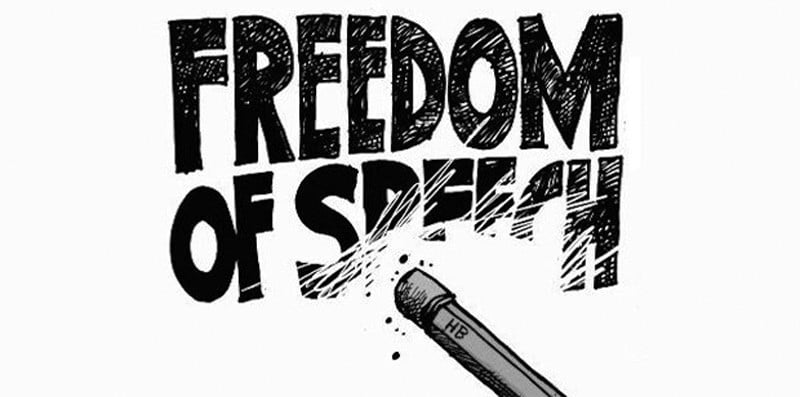
Early this month, India’s parliament came close to declaring the whole country a cloistered hermitage where no evil will be seen, heard, or spoken

Free speech is not about raging at the walls of an empty room. It also involves the right to be heard. And the limits to freedom could be reasonably drawn with speech that offends a person of robust common sense. Free speech requires fearless listening.
Yet, thresholds of tolerance are notoriously low in a world where offence is a political resource no actor is willing to surrender. Early this month, India’s parliament came close to declaring the whole country a cloistered hermitage where no evil will be seen, heard, or spoken.
The occasion was the scheduled telecast of a documentary on the gang rape and evisceration of a young woman in Delhi in December 2012 that led to her death. Pronouncing himself deeply pained by the contents of the film, Home Minister Rajnath Singh declared that all necessary instructions to ban its broadcast in India and elsewhere had been issued. It was another matter that the putative ban perhaps only created a still larger audience for the film on video-sharing websites.
Promos for India’s Daughter, produced and directed by British filmmaker Leslee Udwin, began appearing on social media sites of news broadcaster NDTV 24×7 on March 1. These spoke of an interview with one of the accused, Mukesh Singh, since convicted and sentenced to death, which testified to his moral certitude and complete lack of remorse.
A competing channel was not about to let the opportunity go. Times Now, which has long since reduced itself to a caricature of serious news analysis and debate, went quickly on air with elaborately simulated indignation. With an anchorperson who has set himself up as the nation’s tribune, holding forth with contemptuous aggression towards dissent and unctuous deference to authority, the stage was set for a bonfire of free speech.
Issues of aesthetics and factual veracity -- and there are several that could be raised about the film -- were quickly buried as agitated minds turned their attention obsessively to Mukesh Singh’s unrepentant attitude. Lawyers who represented a seemingly lost cause emerged as loutish and ill-informed, mirroring all the perversities of the criminals they were appointed to defend.
A group of feminists and civil liberties activists, all highly respected in diverse ways, denounced the locutions of the rape convict as "hate speech" which threatened public order. Others fumed that a convict had been afforded a bully pulpit. Members of the ruling party fretted over the defamation of the nation. And still others worried about a possible decline in tourist arrivals.
What is the status in law here? In 1994, M.S. Sathyu, the famed director of the partition family drama, Garam Hawa, sought permission to interview Dhananjay Chatterjee, a convict awaiting execution for the rape and murder of a child. Denied permission by prison authorities, Sathyu approached the Supreme Court and won the right to conduct an interview on camera, conditional on the subject’s informed consent. In the famous words of the court: "The media has the right to every criminal. Likewise, every criminal has the right to every media". There was a caveat attached: the interview could not be broadcast or disseminated in any way till the prisoner’s appeal was finally heard and the inevitable mercy petition disposed of.
Chatterjee’s mercy petition was rejected in 2004 and he was executed soon afterwards. Yet Sathyu’s film, an hour-long voyage into the moral repugnance of capital punishment, did not secure a screening till 2012.
The formal language of the Indian Constitution allows for restrictions on free speech to safeguard against contempt of court. The court’s ruling in the Dhananjay Chatterjee matter seemingly added the administration of justice as another criterion under which speech could be restrained.
In July 2013, the National Law University (NLU) in Delhi began an ambitious project to gather and analyse all available information on capital punishment. Every execution since Chatterjee’s, which broke a long but undeclared moratorium, has triggered public debate since there is a strong current of opinion for abolition. There is little information in the public domain though on the numbers on death row and the circumstances in which they were convicted.
"Aside from pens and paper, every other recording device was prohibited in each of the prison interviews the NLU carried out," reveals project director and legal scholar, Anup Surendranath. And as part of their ethical guidance, investigators made it a point to fully brief interviewees about the purpose of the project and the manner in which the information would be used. On the project website (), the identities of all prisoners are protected so that the further judicial process is not affected in any way.
No such norms seem to have been followed in the case of India’s Daughter. Prison authorities seemingly only reserved to themselves the right to finally approve of the manner in which recordings were used. When faced with a copious volume of footage, their judgment and nerve seemed to fail. Rather than deal with interminable delay, the filmmaker then made a unilateral decision. In the bargain, ethical questions on the administration of justice were thrown overboard.
Speaking in parliament just after the Home Minister, independent member, Anu Agha, warned that self-delusion was not a prudent course for a nation struggling to deal with the pathologies of patriarchy. And Javed Akhtar spoke of the salutary public service the documentary had rendered by bringing every man in intimate contact with the potential rapist in him. Yet, these proved cries in the wilderness since the mood of the moment was to evade the tough questions. Without an early judicial ruling which upholds the spirit of the Sathyu decision, free speech risks being severely set back by this incident.